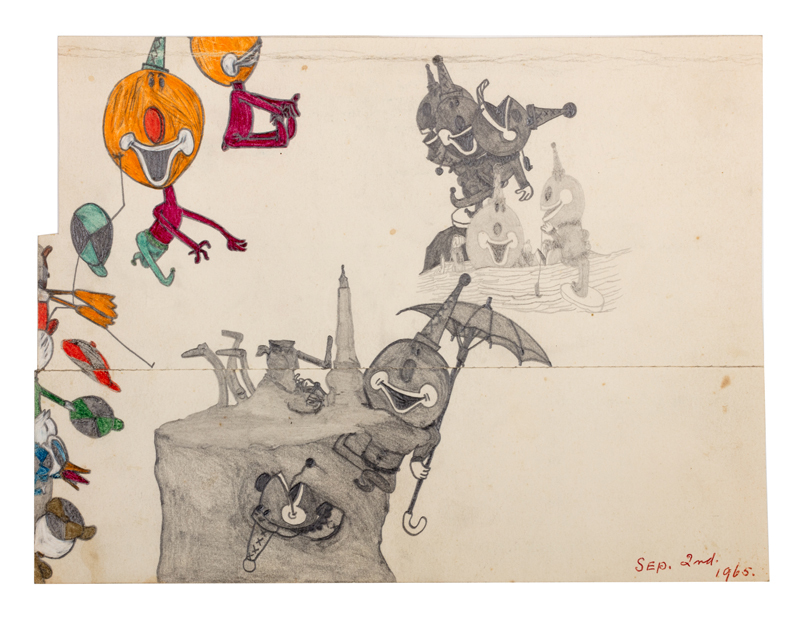An Autistic Woman Who Has Not Spoken for 50 Years Becomes a Surprise Art Star: Inspiring Genius Shows Us New Worlds
BY Catherine D. Anspon // 06.27.17Susan Te Kahurangi King's "Untitled," 1966-1967. The autistic outsider defied all odds, and is now showing at Marlborough Contemporary London. The Marlborough brand conveys authority in the art world.
This summer, visionary artist Susan Te Kahurangi King, who has autism spectrum disorder and has not fully spoken for more than 50 years, is making her European gallery debut at Marlborough Contemporary London (June 1 to July 1). Dallas Art Fair co-founder Chris Byrne curated her show, which has earned critical praise — as well as acquisitions by a pair of collectors who are MoMA trustees. King’s peers also stopped by to pay respects, including painters Oscar Murillo and Sarah Dwyer, conceptual talent Mandy El Sayegh, Turner Prize-winner Martin Creed, critic Kenny Schachter, and multimedia artist Paula Crown who is based in Chicago.
Here’s a little background of how King came to be the surprise breakout star of the London scene.
In Maori, Susan King’s mystical middle name, Te Kahurangi, means “the treasured one.” Her parents were enamored with New Zealand’s native people, among whom they lived and worked. Her father was a self-taught Maori language scholar whose day job was an editor at a publishing company. Her mother was an avid gardener, one-time Maori Sunday school teacher, and, above all, a homemaker to a close-knit brood of 12 children.
Susan, the second oldest, was the first-born daughter. She came along in 1951, when her parents were residing in a small farming community, Te Aroha, on New Zealand’s North Island.
The artist’s tale is improbable and fated, laid out in the recent volume The Drawings of Susan Te Kahurangi King (Institute of Contemporary Art, Miami, 2016). The book details King’s rise to art world prominence despite severe autism spectrum disorder and the geographical disadvantage of living in Auckland, far from the art action. One must credit the role her family played, lovingly and meticulously preserving drawings from her earliest childhood and relocating the family to Auckland so their daughter could enroll in a special-needs school.
King kept up her drawing over the decades, except for a 20-year hiatus when she suddenly stopped taking pencil and pen to paper in the early 1990s. She fortuitously resumed in 2008, on the occasion of a film being made about her work (Pictures of Susan, Octopus Pictures, released 2012).
In 2013, artist Gary Panter of Pee-wee’s Playhouse fame discovered her work via Facebook and brought it to the attention of Chris Byrne. About King, Panter eloquently noted in the artist’s 2016 exhibition catalog: “She … brings us glimpses of another dimension that resides within us all. She is a fountain.”
Due to Byrne’s curatorial acumen and persistence, King has now been introduced to a wider public, including exhibitions at the Outsider Art Fair (Paris and New York, beginning in 2013) and a solo at Andrew Edlin Gallery in Manhattan in 2014, which garnered glowing reviews in Hyperallergic, Huffington Post, Art in America, and The New York Times. Thanks to Byrne, King is represented today by Edlin, who is known as the dealer for self-taught artists.
While the discovery of King is a captivating narrative, the drawings themselves are what stand up to the story. Sure-footed, yet not straightforward, they lead the viewer through a dizzying array of perspectives, introducing characters from TV and Pop culture (Donald Duck and Bugs Bunny to Fanta Man, the brand ambassador of a soda pop) while varying in viewpoint and style from lyrical, inventive closeups to more complex, dense arrays of mark-making that resemble a landscape.
The outsider artist has achieved insider status and been compared to 20th-century Pop master Roy Lichtenstein, as well as today’s painters who embed cartoon imagery in their canvases, such as Joyce Pensato and Sue Williams. We predict Marlborough’s solo for King will continue the spiral of recognition, serving as an antidote to what the jaded art world needs.
What began as a disability, can be seen as a gift of seeing the world through her drawing.
One aside: I met and broke bread with King when she traveled to the U.S. last year. We connected on Labor Day, along with her sister and brother-in-law, Petita and Bryson Cole, and a Houston artist pal, Susan Plum, who has exhibited in New Zealand. The dinnertime visit at Brenner’s on the Bayou, selected for its green space, was memorable and authentic. King seemed to be taking it all in, joining with gusto. But sans speech, it was impossible to know what she was thinking.
At the end of the night, dropping the family off at their Galleria hotel, she unexpectedly gave Plum and me a hug. It was an evening to be remembered — and cherished.
In an exclusive for PaperCity, Byrne queries King’s sister, Petita Cole, via email about the road to this summer’s Marlborough milestone, the artist’s childhood in New Zealand, why London represents a return — and a chance to find two lost works — as well as insights into the drawing process, and the artist’s global “Shut Up and Draw” phenomenon.
Chris Byrne: Will this be Susan’s first visit to London? When we all were together in East Hampton and New York, she seemed to enjoy traveling.
Petita Cole: Yes, Susan really enjoys traveling, seeing new people and places. She’s never been to England before. I’m sure she’ll love it! I saw that the exhibition is not too far from Buckingham Palace. Over the years, Susan, like the rest of us kids, heard many stories from grandma about the queen, the soldiers, and the wonderful palace. Grandma was a keen follower of the royal family and often showed us her treasured photos, news clippings, and memorabilia. It was a particularly memorable occasion when Queen Elizabeth visited New Zealand in the 1970s. I remember being impressed by the number of police at the processions. Both the queen and the police are featured in some of Susan’s drawings from around that time.
CB: In addition to the exhibition of drawings, Marlborough Contemporary plans to host “Drawing with Susan.” What are the origins of this event? We participated in one during Susan’s exhibition at the Institute of Contemporary Art, Miami [in 2016].
PC: “Drawing with Susan” has come to be a signature event associated with her exhibitions. We began hosting these drawing sessions in June 2013, originally called “Shut Up & Draw,” on a monthly basis from our home. Quite a few people had told us how they were inspired by Susan’s works. Others had asked about the possibility of meeting Susan and drawing alongside her. So that’s how “Shut Up & Draw” (SUAD) was born. We kept up the pace running the sessions monthly, through late 2014, when it suddenly took on a whole new dimension. In October 2014, having travelled to the USA for Susan’s first solo show at the Andrew Edlin Gallery in New York, rather than missing that month’s SUAD, we took it with us to America. In fact, we had three that month; one in Los Angeles, one in New York, and one in Seattle; each session had a totally different flavor dependent upon the local ingredients, one might say. Since then, “Drawing with Susan” sessions have been held in conjunction with many of her exhibitions both in the USA and in New Zealand.
CB: What was Susan like as a child?
PC: Susan was adventurous. Even when she was quite young, about six years old, she was known to sneak off into the bush or head into town alone, riding her big-wheeled tricycle. Sometimes she was gone for hours. Once she even got on a bus and traveled to a nearby town on her own. She loved to explore and find things out for herself, whether it be to check the prickliness of a hedgehog spike or to pick up a hot piece of coal (despite warnings) just to check if it really was hot. She also delighted in catching wasps with her bare hands, even though previous attempts had resulted in nasty stings. She loved all kinds of creatures — insects, birds, cats, frogs, etc., but was scared stiff of dogs and elephants. She was just three years old when Dad was doubling her on his pushbike. The footrest gave way, and her ankle got caught in the spokes, resulting in a nasty wound, right down to the bone. It became infected and took quite some time to heal. At around that time she become very anxious and fearful of a number of things, including a phobia of going into small rooms. She loved drawing from a very early age and would spend hours at it. She also used to love scratching images in the sand with a stick or spade.
CB: When did you and your family first recognize Susan’s extraordinary gift as an artist and draftsperson?
PC: The family have always known Susan’s drawings are very clever. But it’s only in recent years that her works have come to the attention of the right people to acknowledge and appreciate the unique level of her skills as an artist. In 1962, grandma showed Susan’s drawings to our relatives in Ireland. They were very interested and said, “She could really make a name for herself.” But we had no idea how that could actually happen.
CB: My personal favorite is the Fanta Man character, which will be featured in the London show. Do you recall when these images were first introduced to her and when they subsequently appeared in her own work?
PC: As far as I know, the Fanta Man character never really had a name. It’s what grandma called it, when referring to the character in Susan’s drawings, so we called it that too. It was around the mid 1960s, back when the iconic clown began showing up in the Fanta [soda] advertisements here in New Zealand. The most prominent advert we saw was a big billboard not far from dad’s job in Queen Street, Auckland city. Susan’s drawings featuring the Fanta Man span from 1965 to 1968, and he appears in the most wonderful and wacky ways.

CB: When did Susan stop speaking?
PC: Susan’s ability to speak began to diminish when she was around three or four years old. During that period of decline, grandma kept an inventory of all the words and phrases Susan uttered, when she said them, and the contexts in which Susan tried to talk. According to the records, by the time she had reached the age of seven, her ability to speak was a thing of the past.
CB: Has she spoken since then?
PC: As recorded in grandma’s diary, during one of Susan’s holidays with her in May 1961, although Susan was not speaking, she would sing in bed at night. Grandma listed the titles of the songs she sang. Also during that holiday, it is recorded that when grandma had been telling grandpa about a funeral she had been to that day, Susan interjected, saying, “Dead, dead, dead.” A few years ago, my sister, Wendy, came across someone who recognized Susan. It was a lady who used to work at the school that Susan attended years ago. The lady reminisced about how one day Susan came up to her, touched her pregnant belly and said, “Baby.” Susan was 21 years at the time. The lady was amazed but never got around to telling the family at the time.
CB: You’ve mentioned that your maternal grandmother Myrtle Murphy was very close to Susan and took a keen interest in her drawing, keeping journal entries about images that appeared over a number of years.
PC: Yes, Susan spent a lot of time with grandma, especially in her early years when she had a number of lengthy stays. There was grandpa too, but the interactions she had were mostly with grandma. Many interesting discoveries and revelations are made about Susan and her drawings by reading grandma’s diaries. The photos she took are a great help, too.
CB: When I’ve had the chance to visit, I see Susan relentlessly drawing away as well as taking trips and participating in family activities. What kinds of things does she enjoy these days?
PC: Susan continues to draw prolifically, but not at the expense of missing out on other things. She enjoys frequent outings to the shops, parks, and the local swimming pool and gym. She enjoys being included of the various busy family happenings. Recently there’s been a lot of clearing and renovating at the family home of 57 years, as we get it ready for sale. Somehow Susan finds a quiet spot right in the middle of all the boxes and settles down to draw. She’s very relaxed and happy.
CB: Has Susan’s work ever been exhibited in London before?
PC: Actually I’m pleased you asked. If your question happens to lead to a discovery, that would be amazing! Way back in 1973, our parents received a letter from the Intellectually Handicapped Society for Children (IHC) school, the day school Susan attended for almost 30 years. The letter was to inform us the IHC staff had entered some of Susan’s works in an international competition, held in London.
Although they were said to be “paintings,” they would just as likely have been drawings. Two of them were successful and shown at the exhibition. The IHC school received a certificate to that effect, and had it framed with the intention of giving it to Susan. Included in the letter [for Susan] was a check for three pounds. This was payment for the “paintings” sold to the general public after the exhibition. The family has no idea what the works actually looked like, nor who they were sold to. I wonder if it would be possible to track any of those acquisitions. It would be neat to see them again.
































_md.jpeg)







